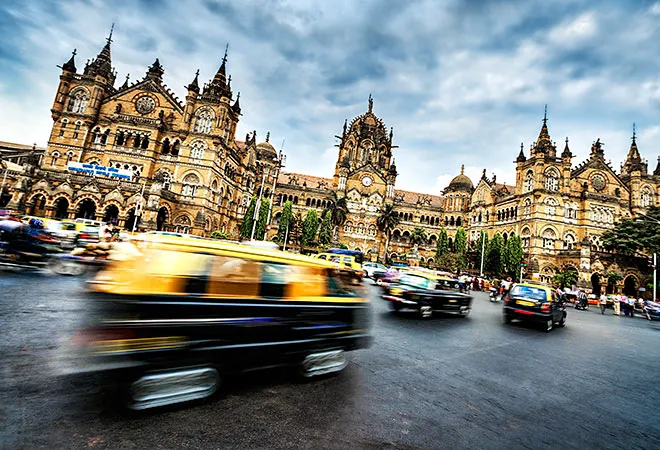
< lang="EN-US" style="font-size: 12.0pt;line-height: 107%">This article is part of the series — Colaba Edit.
< lang="EN-US" style="font-size: 12.0pt;line-height: 107%">Mumbai has been < lang="EN-US">< style="font-size: 12.0pt;line-height: 107%">ranked< lang="EN-US" style="font-size: 12.0pt;line-height: 107%"> the second most congested city in the world in terms of vehicular traffic in 2020, rising two spots from its ranking in 2018 and 2019. Despite life coming to a standstill in early 2020 as India and other countries imposed lockdowns to control the COVID-19 contagion, lifting restrictions saw a quick revival of bumper-to-bumper traffic in Mumbai.
< lang="EN-US" style="font-size: 12.0pt;line-height: 107%">In some way, the perennial traffic jams epitomise the lost opportunities that have restrained Mumbai from fulfilling its true potential over the decades. Once a bustling entrepôt that was the ‘gateway’ to India, today's Mumbai is plagued by numerous physical and social infrastructure constraints, despite being India’s financial capital. Many of these shortcomings have resulted in uneven development where pockets of prosperity survive in a sea of deprivation. For one, nearly < lang="EN-US">< style="font-size: 12.0pt;line-height: 107%">42 percent of Mumbai’s population< lang="EN-US" style="font-size: 12.0pt;line-height: 107%"> resides in slums, largely deprived of adequate and clean water supply and sanitation. Studies estimating the impact of rising sea levels on coastal cities have already predicted large areas of Mumbai will be < lang="EN-US">< style="font-size: 12.0pt;line-height: 107%">submerged< lang="EN-US" style="font-size: 12.0pt;line-height: 107%"> by 2050. Slum settlements, which are in the city's low-lying marshy areas, are likely to be worst affected. Such inherent and unresolved problems are poised to increase Mumbai’s vulnerability.
Many of the shortcomings have resulted in uneven development where pockets of prosperity survive in a sea of deprivation.
< lang="EN-US" style="font-size: 12.0pt;line-height: 107%">Given these challenges, Mumbai needs to make a fresh start on several physical, socioeconomic and regulatory parameters. The city contributes well over half of Maharashtra’s GDP, which at < lang="EN-US">< style="font-size: 12.0pt;line-height: 107%">US$467 billion< lang="EN-US" style="font-size: 12.0pt;line-height: 107%"> is India’s largest regional economy. Mumbai will thus play a pivotal role if India is to become a < lang="EN-US">< style="font-size: 12.0pt;line-height: 107%">US$10 trillion economy< lang="EN-US" style="font-size: 12.0pt;line-height: 107%"> by 2030. For instance, the GDP of < lang="EN-US">< style="font-size: 12.0pt;line-height: 107%">other global cities< lang="EN-US" style="font-size: 12.0pt;line-height: 107%"> such as New York City and Tokyo is close to US$1 trillion, nearly equal to the GDP of countries such as < lang="EN-US">< style="font-size: 12.0pt;line-height: 107%">Indonesia< lang="EN-US" style="font-size: 12.0pt;line-height: 107%"> and < lang="EN-US">< style="font-size: 12.0pt;line-height: 107%">Canada< lang="EN-US" style="font-size: 12.0pt;line-height: 107%">.
< lang="EN-US" style="font-size: 12.0pt;line-height: 107%">Mumbai has had opportunities to turn its fortunes around. For a city that has been increasingly cramped for space because of its linear dispensation, the proposed opening up of < lang="EN-US">< style="font-size: 12.0pt;line-height: 107%">966 hectares< lang="EN-US" style="font-size: 12.0pt;line-height: 107%"> (nearly 10 sq km) of the idle eastern waterfront — currently owned by the Mumbai Port Trust — seemed like a panacea. With shipping, maritime, and coastal trade moving to ports around Mumbai and neighbouring Gujarat, Mumbai’s eastern waterfront’s exploitation can offer much more than just leisure infrastructure, marinas, and international cruise terminals. The development blueprint, currently awaiting the government’s nod, includes 26 percent of the total land area as < lang="EN-US">< style="font-size: 12.0pt;line-height: 107%">open spaces and gardens< lang="EN-US" style="font-size: 12.0pt;line-height: 107%">. Mumbai currently has just 8 percent publicly accessible open spaces. Public thoroughfares will cover 36 percent of the land area as against the current 17 percent in the city.
Some of the world’s largest financial centres — which were catapulted on the global map and that catalysed local, domestic and regional economies — occupy a much smaller area than Mumbai’s eastern waterfront.
< lang="EN-US" style="font-size: 12.0pt;line-height: 107%">If the government is any wiser from its learnings from mills lands redevelopment mistakes in the 1990s, judicious opening up of the eastern waterfront can potentially transform the city into an international powerhouse like Shanghai or Hong Kong. Some of the world’s largest financial centres — which were catapulted on the global map and that catalysed local, domestic and regional economies — occupy a much smaller area than Mumbai’s eastern waterfront.
< lang="EN-US" style="font-size: 12.0pt;line-height: 107%">Spread over merely 40 hectares, London’s Canary Wharf was once a < lang="EN-US">< style="font-size: 12.0pt;line-height: 107%">quay< lang="EN-US" style="font-size: 12.0pt;line-height: 107%"> used to unload imports from the Mediterranean and Canary Islands. Since 1987, the area has emerged as London’s biggest financial district with over 150,000 people employed there, and < lang="EN-US">< style="font-size: 12.0pt;line-height: 107%">generating an annual revenue< lang="EN-US" style="font-size: 12.0pt;line-height: 107%"> of over US$50 billion. In midtown New York, the miniscule area between Manhattan’s 41st and 59th streets covering five zip codes < lang="EN-US">< style="font-size: 12.0pt;line-height: 107%">employ< lang="EN-US" style="font-size: 12.0pt;line-height: 107%"> 600,000 workers who earn more than six-digit US dollar salaries. In Asia, the Dubai International Financial Centre, established in 2004 over 110 hectares, has quickly risen to the < lang="EN-US">< style="font-size: 12.0pt;line-height: 107%">eighth position< lang="EN-US" style="font-size: 12.0pt;line-height: 107%"> among global financial powerhouses, placing it in elite company of London, New York, Hong Kong and Singapore.
Scheduled for commissioning in 2019, the airport is unlikely to see any activity by 2022.
< lang="EN-US" style="font-size: 12.0pt;line-height: 107%">Sadly, the vision for developing Mumbai’s eastern waterfront, including the 2015 mega plan for the establishment of an International Financial Services Centre (IFSC) at the Bandra-Kurla Complex (Mumbai’s new central business district), has been blurred due to < lang="EN-US">< style="font-size: 12.0pt;line-height: 107%">political myopia< lang="EN-US" style="font-size: 12.0pt;line-height: 107%">. < lang="EN-US">< style="font-size: 12.0pt;line-height: 107%">Reports indicate< lang="EN-US" style="font-size: 12.0pt;line-height: 107%"> that the development of the eastern waterfront and the IFSC have been put on hold by the Central government to facilitate Prime Minister Narendra Modi’s pet idea of the Gujarat International Finance-Tech City.
< lang="EN-US" style="font-size: 12.0pt;line-height: 107%">Other mega plans that are critical for enhancing Mumbai’s global profile have also suffered from inordinate delays. The second international airport at Panvel, < lang="EN-US">< style="font-size: 12.0pt;line-height: 107%">conceptualised< lang="EN-US" style="font-size: 12.0pt;line-height: 107%"> in the late 1980s to decongest the saturated Mumbai airport, is nowhere near completion. Scheduled for commissioning in 2019, the airport is unlikely to see any activity by 2022. The estimated project cost of INR 140 billion has already < lang="EN-US">< style="font-size: 12.0pt;line-height: 107%">escalated< lang="EN-US" style="font-size: 12.0pt;line-height: 107%"> to INR 165 billion. The work on the INR 180-crore 22-km-long < lang="EN-US">< style="font-size: 12.0pt;line-height: 107%">Mumbai Tans Harbour Link< lang="EN-US" style="font-size: 12.0pt;line-height: 107%">, conceived in the 1970s to connect the island city with Navi Mumbai, has only begun recently and is unlikely to meet the 2022 completion deadline. The metro lines, urgently required to ease the pressure on the suburban railway services that < lang="EN-US">< style="font-size: 12.0pt;line-height: 107%">ferry nearly eight million commuters daily< lang="EN-US" style="font-size: 12.0pt;line-height: 107%">, have suffered from time and cost overruns. The crucial Metro Line 3, connecting areas hitherto underserved by public transport, has been < lang="EN-US">< style="font-size: 12.0pt;line-height: 107%">delayed< lang="EN-US" style="font-size: 12.0pt;line-height: 107%"> indefinitely owing to populist politics and miscalculated environmental concerns.
Mumbai’s only hope is for planned and sustainable inland expansion beyond Navi Mumbai and Thane.
< lang="EN-US" style="font-size: 12.0pt;line-height: 107%">While sustainable public transport projects have languished, the government has actively pursued car-centric projects such as the 9.8-km Coastal Road along the city’s western coastline. To be built at a projected cost of INR 140 billion, the Coastal Road seeks to reclaim over 100 hectares of land from the sea, turning a blind eye to < lang="EN-US">< style="font-size: 12.0pt;line-height: 107%">grave climate threats< lang="EN-US" style="font-size: 12.0pt;line-height: 107%"> that confront the city.
< lang="EN-US" style="font-size: 12.0pt;line-height: 107%">Inherent weaknesses have also made Mumbai lose out to several of its Indian counterparts. While the < lang="EN-US">< style="font-size: 12.0pt;line-height: 107%">Delhi-National Capital Region< lang="EN-US" style="font-size: 12.0pt;line-height: 107%"> has stolen a march over Mumbai to emerge as India’s economic capital, < lang="EN-US">< style="font-size: 12.0pt;line-height: 107%">Bengaluru< lang="EN-US" style="font-size: 12.0pt;line-height: 107%"> has outpaced Mumbai to emerge as India’s innovation and start-up capital. Even < lang="EN-US">< style="font-size: 12.0pt;line-height: 107%">Hyderabad< lang="EN-US" style="font-size: 12.0pt;line-height: 107%">, the capital of the new state of Telangana, has drawn more foreign direct investment in terms of manufacturing, electronics, pharmaceuticals, biotech and exports.
< lang="EN-US" style="font-size: 12.0pt;line-height: 107%">Mumbai’s only hope is for planned and sustainable inland expansion beyond Navi Mumbai and Thane. The former government cleared the proposal for the greenfield development of India’s largest planned city — < lang="EN-US">< style="font-size: 12.0pt;line-height: 107%">Navi Mumbai Airport Influence Notified Area< lang="EN-US" style="font-size: 12.0pt;line-height: 107%"> (NAINA), to be built over a 334-sq km area at an estimated < lang="EN-US">< style="font-size: 12.0pt;line-height: 107%">cost< lang="EN-US" style="font-size: 12.0pt;line-height: 107%"> of INR 2 trillion. Recently, the government has also cleared the decks for the development of the 300-hectare multi-use < lang="EN-US">< style="font-size: 12.0pt;line-height: 107%">Navi Mumbai Aerocity< lang="EN-US" style="font-size: 12.0pt;line-height: 107%"> on the southern periphery of the demarcated airport. Given the roadblocks these mega projects are bound to face, they too might remain in an unending construction mode.
Clearly the odds are high, but so are the stakes.
< lang="EN-US" style="font-size: 12.0pt;line-height: 107%">Clearly the odds are high, but so are the stakes. Rediscovering Mumbai as a global entrepôt will require much more than infrastructure enhancement and re-engineering. Leveraging Mumbai’s strengths as a financial powerhouse will require regulatory changes and resolving taxation laws’ complexities. Mumbai has lost out to < lang="EN-US">< style="font-size: 12.0pt;line-height: 107%">Singapore and Japan< lang="EN-US" style="font-size: 12.0pt;line-height: 107%">, which have introduced easy tax structures and incentives for foreign investors. Mumbai will have to deal with conflicting federal structures with overlapping jurisdictions and poor capacities on the local front. New tracts of land, such as the eastern waterfront and NAINA, that increase Mumbai’s metropolitan reach must be developed with an emphasis on jobs creation and economic gains and flexibility of mixed land use and optimal linkages through sustainable public transport.
< lang="EN-US" style="font-size: 12.0pt;line-height: 107%">Despite the challenges, Mumbai has what it takes — new space for expansion, a high-skilled industrious population and a thriving private sector. Now, it must get its act together. The successful rediscovery of Mumbai as a global entrepôt will set an example for the rest of the cities, accelerating economic growth and improving urban life quality.
The views expressed above belong to the author(s). ORF research and analyses now available on Telegram! Click here to access our curated content — blogs, longforms and interviews.




 PREV
PREV


